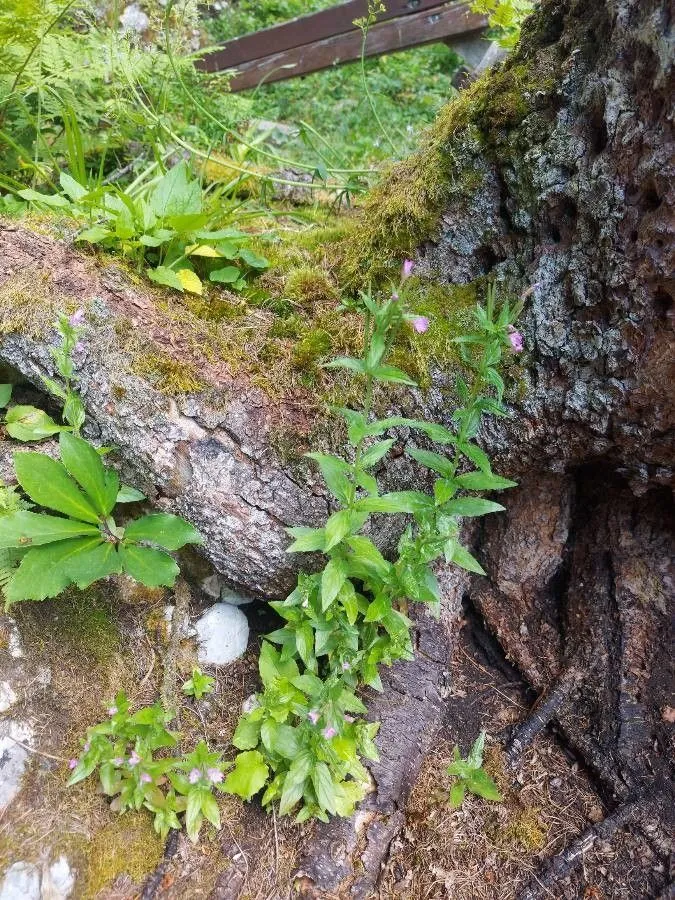
Author: (Jacq.) Krock.
Bibliography: Fl. Siles. 1: 605 (1787)
Year: 1787
Status: accepted
Rank: species
Genus: Epilobium
Vegetable: False
Observations: Europe to Caucasus
The Alpine willowherb, known scientifically as Epilobium alpestre, is a captivating and resilient plant belonging to the family Onagraceae. This species is native to Europe and extends its reach to the Caucasus, thriving in a wide array of mountainous terrains.
Botanically renowned since its documentation in 1787 in “Flora Silesiaca,” this plant was first described by Jacquin and later classified by Krocker. The Alpine willowherb is notable for its adaptability and the charming beauty it adds to European and Caucasian landscapes. It typically flourishes in alpine meadows and on rocky slopes, where it can endure harsh conditions and elevate the aesthetic appeal of its environment.
The physical characteristics of Epilobium alpestre are quite striking. This perennial herb exhibits slender, erect stems that can attain various heights depending on the altitude and growing conditions. The leaves are arranged oppositely, showcasing a lanceolate to oval shape with finely serrated edges, contributing to its delicate appearance.
One of the most alluring aspects of the Alpine willowherb is its flowering phase. During this period, it produces an array of small, yet vividly colored flowers, ranging from soft pinks to deep purples. The blossoms are typically four-petaled and grow in clusters, which can attract a variety of pollinators, including bees and butterflies. Following the flowering season, the plant generates elongated seed capsules that eventually release numerous tiny seeds dispersed by the wind, ensuring the propagation of future generations.
Apart from its aesthetic and ecological importance, Epilobium alpestre holds a particular interest for botanists and plant enthusiasts due to its historical botanical documentation and its resilient nature. It plays a key role in maintaining the floral diversity of alpine and subalpine regions, offering both habitat and nourishment to various wildlife species.
In essence, the Alpine willowherb is not only a plant of remarkable beauty but also an essential component of its natural ecosystem. Its ability to thrive in mountainous regions underscores the intricate balance and interdependence found in nature’s design.
Deu: quirl-weidenröschen, quirlblättriges weidenröschen
En: Alpine willowherb, Whorled-leaved Willowherb
Ca: Epilobi alpestre
Cs: Vrbovka alpská
Nl: Kransbladige Bastardwederik
Fr: Épilobe à feuilles verticillées, Épilobe alpestre
De: Quirlblättriges Weidenröschen, Quirl-Weidenröschen, Quirliges Weidenröschen
It: Garofanino trifogliato
Pl: Wierzbownica okółkowa
© copyright of the Board of Trustees of the Royal Botanic Gardens, Kew.
© copyright of the Board of Trustees of the Royal Botanic Gardens, Kew.
© copyright of the Board of Trustees of the Royal Botanic Gardens, Kew.
Taken Jul 1, 2016 by Tela Botanica − Yoan MARTIN (cc-by-sa)
Taken Aug 14, 2016 by Tela Botanica − Yoan MARTIN (cc-by-sa)
Taken Aug 14, 2016 by Tela Botanica − Yoan MARTIN (cc-by-sa)
Taken Jul 20, 2020 by Jiří Kubeš (cc-by-sa)
Taken Jul 22, 2021 by Elisabeth Ellu (cc-by-sa)
Taken Jul 9, 1999 by Tela Botanica − Liliane ROUBAUDI (cc-by-sa)
Taken Jul 1, 2016 by Tela Botanica − Yoan MARTIN (cc-by-sa)
Taken Jul 1, 2016 by Tela Botanica − Yoan MARTIN (cc-by-sa)
Taken Jul 1, 2016 by Tela Botanica − Yoan MARTIN (cc-by-sa)
Taken Jul 1, 2016 by Tela Botanica − Yoan MARTIN (cc-by-sa)
Taken Jun 18, 2018 by Tela Botanica − Liliane ROUBAUDI (cc-by-sa)
Taken Jul 1, 2016 by Tela Botanica − Yoan MARTIN (cc-by-sa)
Taken Jun 18, 2018 by Tela Botanica − Liliane ROUBAUDI (cc-by-sa)
Taken Aug 14, 2016 by Tela Botanica − Yoan MARTIN (cc-by-sa)
Taken Jul 22, 2021 by Elisabeth Ellu (cc-by-sa)
Taken Aug 15, 2021 by Bernard Haute Savoie (cc-by-sa)
Taken Aug 10, 2015 by Tela Botanica − Daniel CAHEN (cc-by-sa)
Taken Aug 21, 2014 by Tela Botanica − Liliane Roubaudi (cc-by-sa)
Taken Aug 21, 2014 by Tela Botanica − Liliane Roubaudi (cc-by-sa)
Taken Aug 21, 2014 by Tela Botanica − Liliane Roubaudi (cc-by-sa)
Taken Jul 15, 1996 by Photoflora – Jean-Luc TASSET (©)
Taken Jul 15, 2009 by Photoflora – Jean-Luc TASSET (©)
Taken Jul 9, 2013 by Tela Botanica − Liliane Roubaudi (cc-by-sa)
Taken Jan 1, 1800 by Tela Botanica − Thierry Pernot (cc-by-sa)
Taken Jul 10, 2013 by Tela Botanica − Geneviève Botti (cc-by-sa)
Taken Jan 1, 1970 by Photoflora – L’Abbé COSTE (©)
Taken Aug 21, 2014 by Tela Botanica − Liliane Roubaudi (cc-by-sa)
Ph maximum: 7.0
Ph minimum: 6.5
Light: 7
Atmospheric humidity: 8
Bloom months: [‘jul’, ‘aug’]
Soil nutriments: 8
Family: Myrtaceae Author: (F.Muell.) K.D.Hill & L.A.S.Johnson Bibliography: Telopea 6: 402 (1995) Year: 1995 Status:…
Family: Rubiaceae Author: Pierre ex A.Froehner Bibliography: Notizbl. Bot. Gart. Berlin-Dahlem 1: 237 (1897) Year:…
Family: Sapindaceae Author: Koidz. Bibliography: J. Coll. Sci. Imp. Univ. Tokyo 32(1): 38 (1911) Year:…
Family: Asteraceae Author: A.Gray Bibliography: Pacif. Railr. Rep.: 107 (1857) Year: 1857 Status: accepted Rank:…
Family: Fabaceae Author: Medik. Bibliography: Vorles. Churpfälz. Phys.-Ökon. Ges. 2: 398 (1787) Year: 1787 Status:…
Family: Aspleniaceae Author: (Cav.) Alston Bibliography: Bull. Misc. Inform. Kew 1932: 309 (1932) Year: 1932…